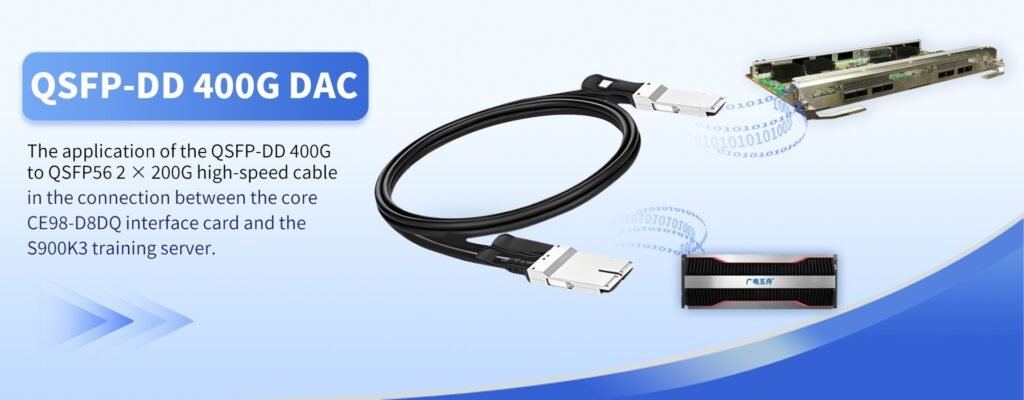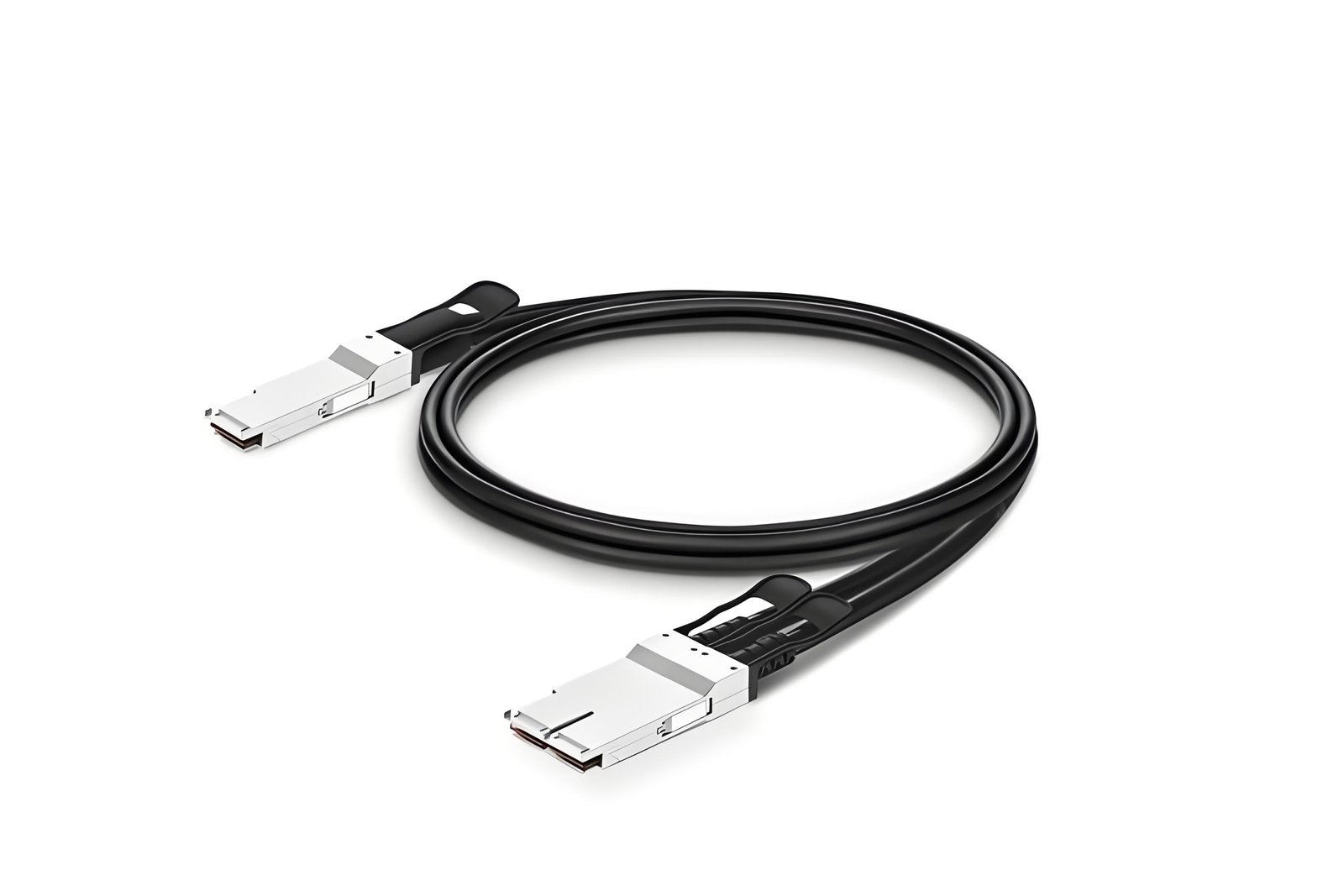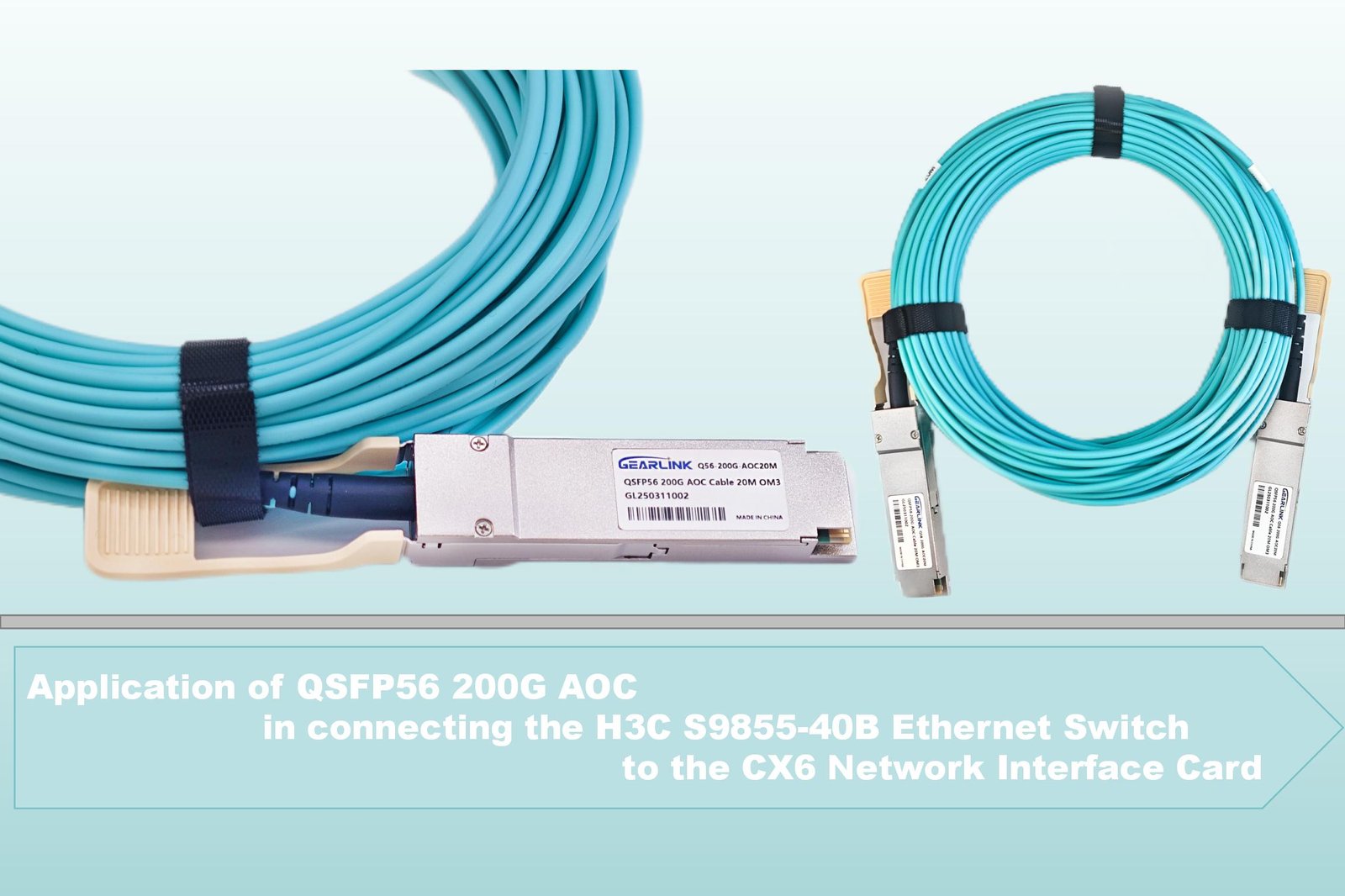1. Introduction to QSFP-DD 400G to QSFP56 2×200G High-Speed Cable
QSFP-DD (Quad Small Form-Factor Pluggable Double Density) is a next-generation high-speed interface standard for optical communications, widely used in 400G data centers, cloud computing, artificial intelligence (AI), and high-performance computing (HPC) environments. The QSFP-DD 400G to QSFP56 2×200G high-speed cable is a passive direct attach copper (DAC) cable designed for high-speed data transmission, enabling one 400G port to split into two 200G ports.
1.1 Key Features
- High Bandwidth Support: This cable features a QSFP-DD connector at one end, delivering 400G transmission, and splits into two QSFP56 connectors, each supporting 200G data rates.
- Low Power Consumption: As a passive DAC, it consumes significantly less power compared to active optical cables (AOC) or optical transceiver solutions, helping reduce overall data center power usage.
- Ultra-Low Latency: DAC cables offer minimal transmission latency, making them ideal for latency-sensitive scenarios such as AI training and data center interconnects.
- High Reliability: Built with high-quality materials, the cable ensures excellent signal integrity and electromagnetic compatibility for stable high-speed transmission.
- Plug and Play: Supports hot-pluggability, requires no external power, and is easy to deploy.
1.2 Application Scenarios
This cable is widely used in data centers, cloud environments, HPC systems, and AI training clusters. In academic intelligent computing centers, it serves as a high-bandwidth, low-latency link between core switches and AI training servers.
2. Device Port Overview and Compatibility Analysis
To achieve high-speed connectivity between the Huawei CE98-D8DQ interface card and the Guangdian Wuzhou S900K3 training server, it’s essential to evaluate their port specifications and verify compatibility with the QSFP-DD 400G to QSFP56 2×200G DAC cable.
2.1 Huawei CE98-D8DQ Interface Card
The CE98-D8DQ is a core switch interface card designed for data centers and HPC environments, featuring high-density 400G ports and powerful forwarding capabilities.
- Port Type:
- 8 × 400GE QSFP-DD optical ports, compatible with QSFP-DD 400G optical transceivers
- Supports breakout configurations including 400G, 200G, and 100G rates Fully compatible with QSFP-DD to QSFP56 2×200G DAC cables
2.2 Guangdian Wuzhou S900K3 Training Server
The S900K3 is an AI training server typically equipped with high-performance GPUs or dedicated AI accelerators and supports high-speed network connectivity.
- Port Type:
- 8 × 200GE QSFP56 ports, supporting RoCE and compatible with QSFP56 200G optical transceivers
- Supports DAC or AOC solutions for connectivity with switches Compatible with QSFP-DD to QSFP56 2×200G DAC breakout cables
3. Connection Solution and Application Advantages
In academic intelligent computing centers, AI training environments require high-speed server-to-switch connectivity to enable efficient data exchange. This solution utilizes QSFP-DD 400G to QSFP56 2×200G DAC cables to connect the Huawei CE9860-4C-EI-A core switch with S900K3 AI training servers.
3.1 Connection Method
- The Huawei CE9860-4C-EI-A switch is equipped with the CE98-D8DQ interface card, which offers QSFP-DD 400G ports.
- The QSFP-DD 400G to QSFP56 2×200G DAC cable is plugged into the 400G port and split into two 200G QSFP56 ports.
- These 200G QSFP56 ports are directly connected to the QSFP56 200G ports on the Guangdian Wuzhou S900K3 training server, enabling high-bandwidth interconnection.

3.2 Application Advantages
- High Bandwidth: Splits a 400G port into two 200G ports, meeting high-speed server connectivity requirements.
- Ultra-Low Latency: The DAC solution offers lower latency compared to fiber optic transceiver-based solutions, ideal for latency-sensitive AI workloads.
- Energy Efficient: Passive DAC cables consume very little power, reducing total data center energy usage.Easy Deployment: Plug-and-play functionality eliminates the need for optical transceiver installation and configuration, simplifying deployment.
4. Conclusion
In AI training environments within academic intelligent computing centers, high-speed server-to-switch interconnection is crucial. This QSFP-DD 400G to QSFP56 2×200G DAC cable solution leverages the full potential of the Huawei CE9860-4C-EI-A switch’s 400G ports, providing the Guangdian Wuzhou S900K3 training server with a high-bandwidth, low-latency interconnect.
This solution not only enhances data transmission efficiency for AI workloads but also reduces power consumption and deployment costs. It offers a cost-effective, high-performance interconnect strategy for building next-generation intelligent computing infrastructure.
By adopting this approach, academic intelligent computing centers can construct high-throughput, energy-efficient networks, significantly improving the performance of AI training clusters and laying a robust foundation for smart computing applications.



